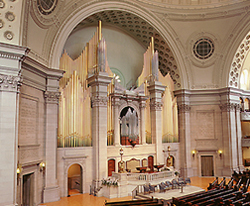
Music schools across the country have rehearsal and performance halls that have been carefully sculpted to envelop both the musicians and audience with reflected sound.
While virtually all traditional musical instruments depended on the stage and room for acoustic support, one instrument developed that took it even further. For a pipe organ, the room is part of the instrument. A dense reverberant field envelopes the listening with sound from the many pipes used to generate the musical tones.
Rooms that are deemed suitable for pipe organ (and the human equivalent – a choir) have reverberation times in the 4- to 5-second range. This means that the reverberation time must be even longer if the room is empty. Since communication was next to impossible in these spaces, liturgical services were sometimes sung rather than spoken, often in a language unfamiliar to the congregation.
Here And Now
The era of electronic music began in the mid-1960s with the invention of the electric guitar. The first versions were simply acoustic instruments outfitted with electronic pickups. They could be played with or without electronic amplification.
The solid body electric guitar had very little acoustic sound, and could only be heard when plugged into a guitar amplifier. They had a characteristic sound determined mainly by their pickup design and configuration, and the density of the wood to which the pickup was mounted.
The guitar amplifier had such a profound effect on the sound that it was soon recognized as port of the instrument itself. Various makes and models became preferred for their characteristic sound, and a good amplifier technician could modify the electronics to produce a sound pleasing to the musician.
Because the guitar and amplifier could product almost any sound level, there was no need to rely on room acoustics for support. In fact, since the instrument was plucked rather than bowed, the staccato sound could easily be aggravated by echoes in the auditorium, and the desired sound of the instrument lost in a sea of reflections.
Add to this the fact that acoustic drums almost always accompanied the guitar. These were quite loud and also staccato, and their sound was equally aggravated by echoes from the room.
Musicians and club owners quickly learned that acoustically live rooms could dramatically detract from a performance. Musical venues were draped with curtains and padded seats in an effort to reduce the room reflections.
